Issue 9 – Spring 2023

News and Views on branding tech and innovation by law firms
News
New brands and refreshed ones.
Firms have been busy introducing new brands and revitalising others to help strengthen their positioning. Here are a few recent examples:
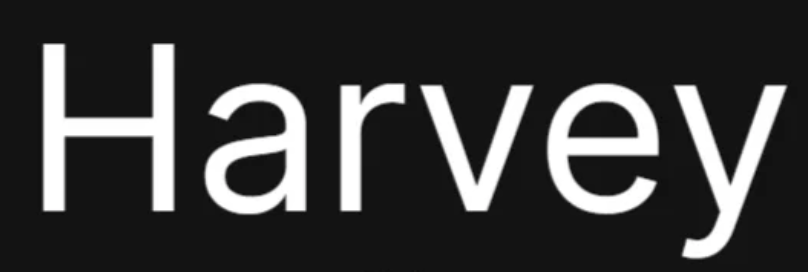
Call me Harvey
‘Meet Harvey’. This is how Allen & Overy (A&O) dubs its version of Open AI’s latest model for its legal work. A&O has a tech-savvy reputation. Being the first law firm to use Harvey comes as no surprise. But why call it Harvey? Not an obvious name for a legal AI bot. One of Harvey’s five employees listed on LinkedIn has the same surname. Could it be that simple? Harvey is the name of a six-foot invisible rabbit in a 1950’s film and TV series of the same name. Did the founders take inspiration from that? ‘Harvey, your invisible friend, always by your side!’. The actual tagline doesn’t come close: ‘Unprecedented legal AI’ is the boast. There is also the tricky issue of gender diversity to consider, and Harvey is traditionally a boy’s name. Could the founders have avoided the entire gender issue and used a genderless name? Q is the name of the first genderless AI voice, for example. Google uses a genderless name for its AI chatbot calling it Bard (Celtic term for a ‘storyteller’), reflecting “the creative nature of the algorithm underneath”. There is a back-story, but there is no obvious reason why Harvey is Harvey.

Shearman launches new legal ops brand
The role and importance of legal operations is undergoing significant transformation particularly within in-house functions. Several big firms – including Linklaters and Norton Rose Fulbright – have developed a mix of services, solutions and products to help take advantage of the opportunities. US law firm Shearman & Sterling has gone one step further and launched a dedicated sub-brand aimed at corporate law departments. Known as ‘Legal Operations by Shearman’, it will draw together expertise from across the firm. Using the tag-line ‘by Shearman’, the new brand is closely positioned to Shearman & Sterling and takes the firm’s brand identity to help leverage the firm’s reputation.
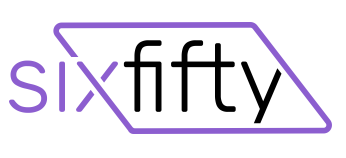
New products. New identity for SixFifty
Wilson Sonsini’s technology subsidiary, SixFifty, recently unveiled a new brand identity. The software subsidiary also strengthened its positioning in automated business documents by introducing a series of new products. The firm remarked, “Over the past year, we have invested heavily in our technology, and our new brand matches our commitment to even better functionality, new tools, and new ways to work with us.” The abstract graphic in the new logo and website subtly reinforces the concept of ‘documents’. The overall effect helps to reinforce the firm’s leading edge, hi-tech qualities.
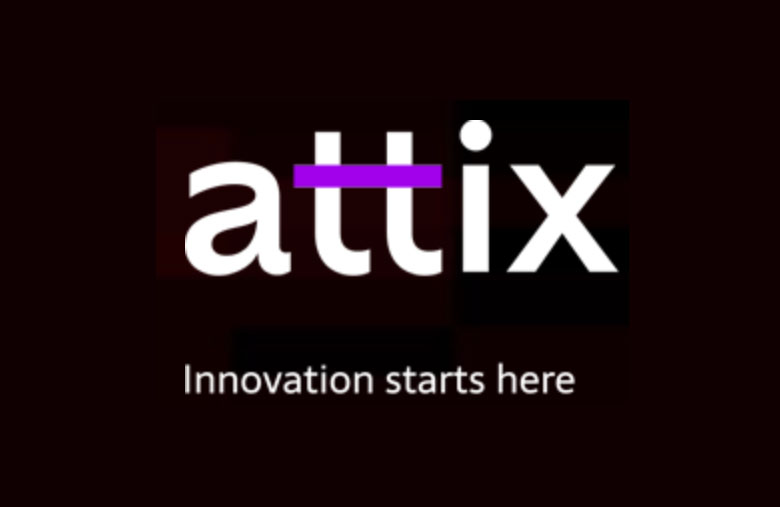
Attix: New Brazilian brand
Tapping into the rich seam of tech start-ups is a proven pathway for accessing new ideas and insights. Brazilian firm Mattos Filho is the latest to join the ranks when the firm launched its innovation programme called attix. The purpose of attix is to connect start-ups with other companies. “We increasingly want to be seen as the connecting bridge between new technologies and our clients’ challenges,” says Lisa Worcman, partner in charge of the initiative.
The firm claims the name attix comes from the word attic, “the highest place in a house – where it is possible to see beyond the horizon.” The firm remarks on its website: “The letters ‘a’ and the double ‘t’ come from Mattos Filho’s brand – strong characteristics of the firm’s name. It also features the letter ‘x’, a concept representing connections and bridges for building partnerships between customers and the best start-ups in the market.”

Reed Smith launches new lab. Going creative with naming labs
Quite a trend, using the word ‘labs’ in the start-up space. Labs are part of the legal landscape. Back in October, Reed Smith joined the ranks launching ‘Innovation Lab’. As the firm claims, “a virtual space for discovering, incubating and accelerating creative ideas at the firm and alongside clients.” Reed Smith used the association of ‘innovation’ and ‘labs’ for its name. Others stay close to the firm’s name, for example, MDR Lab (Mishcon de Reya) and R&G Insights Lab (Ropes & Gray).
A few are more creative. Dentons harnesses the thought of ‘future law’ with ‘Nextlaw Labs’. Kennedys highlights the output of any lab using ‘Ideas Lab’. Clifford Chance uses the theme of ‘creativity’ for its Singapore-based lab called ‘Create’. The firm added ‘+65’ to the name (‘Create+65) to give it more of a ‘tech’ feel (+65 is Singapore’s international calling code!).
There are a few (outside of law) that have chosen not to use the labs terminology, such as Amazon’s A9 and Google, which now has Google X. No matter the name, there’s something powerful in the word ‘labs’ that reminds us of the old school chem lab and that spirit of experimentation. It is rich in associations. But should it be ‘Labs’ or ‘Lab’? Does pluralizing the word imply diversity and multiplicity of ideas? In the end, it all boils down to semantics. It’s all about how you use it to develop the right associations for your brand.
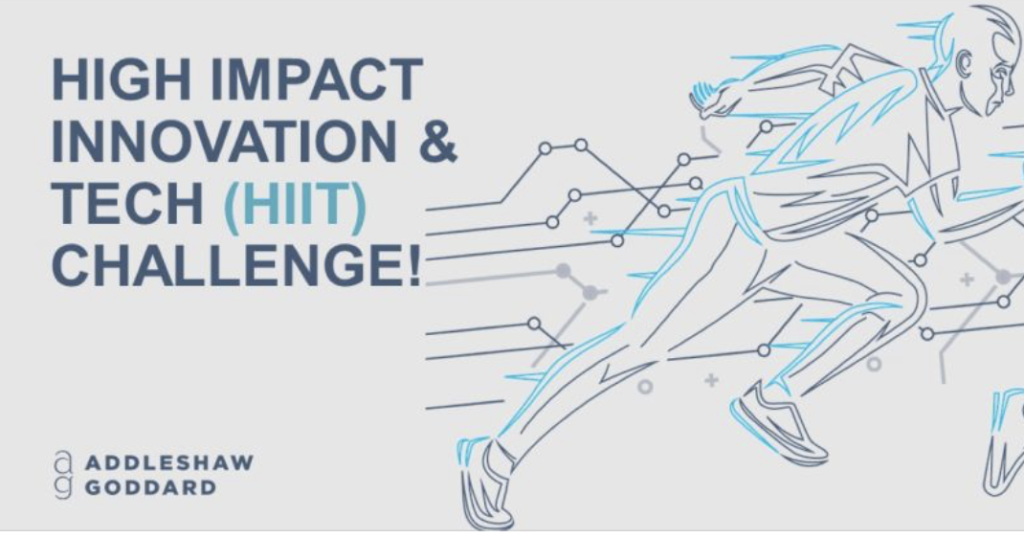
Addleshaw Goddard puts innovation through its paces
Building a culture committed to innovation is no easy task. It takes time and effort. Innovation days are effective tactics in the process. Addleshaw Goddard held a week-long innovation programme called the ‘High Impact Innovation & Tech’ (HIIT) Challenge. Using a fitness theme (after all, it was held in January!), HIIT was a fun-packed programme to put the firm’s teams through their paces with different activities, including: ‘client cardio’ talks; design thinking exercises; document automation races; ideas spinning sessions, and more. Kerry Westland, the firm’s Head of Innovation remarked: “Whilst innovation is something that we as a firm live and breathe on a daily basis, it has been amazing to see the next level buzz and enthusiasm from colleagues across the firm who have taken part in the variety of sessions we have hosted.”
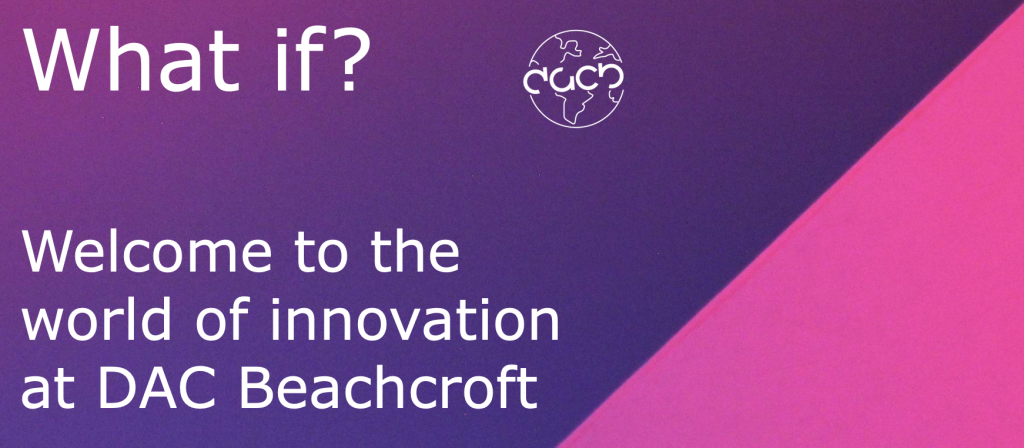
DAC Beachcroft makes some noise for innovation
Talking of internal engagement, DAC Beachcroft developed the curiously named ‘Noisy Innovation’ campaign. Similarly to Addleshaw Goddard, the firm wanted to reap the benefits of buzz and DACB aimed to “raise the volume about innovation within the firm and equip colleagues to talk confidently about the innovative solutions and approaches the firm offers its clients.” The firm goes onto say: “This campaign was fun and engaging and, crucially, noisy. It got our colleagues excited about innovation and was a fantastic way to look back at the many innovation successes we have had since setting up Innovations Lab back in 2016.”
Following the ‘Noisy Innovation’ internal communications campaign, DACB launched ‘What If?’, a 360-degree augmented reality experience that showcased innovation at the firm. Accessed on a mobile phone via a QR code and available to view on VR headsets, the experience invited clients and contacts to open a portal, physically step through and immerse themselves in DACB’s world of innovation. The campaign won the ‘Best Internal Communications from the Professional Services Sector’ category at Communicate magazine’s Internal Communications and Engagement Awards.

Mishcon de Reya and Taylor Vinter: Achieving brand symmetry
With any merger, ensuring there is symmetry and balance in ambitions, cultures, clients and services is fundamental. This is also true of the brands. For brands to align well, both the target customer and the value proposition must be aligned. The recent merger of Mishcon de Reya and Taylor Vinters is a good example of aligned brands. Taylor Vinters is focused on entrepreneurial tech-led businesses. The firm has an excellent reputation for advising early-stage businesses and organisations. Likewise, the Mishcon brand has a famed reputation for working for entrepreneurs and their businesses. It has a strong commitment to innovation too.
The merger has created a new business that will offer legal and consultancy services to “innovators and entrepreneurs and the organisations and ecosystems that support them.” Both firms see the huge potential of bringing together two brands known in the innovation economy, sharing similar values to take advantage of the opportunities in the innovation space.

Features
Back in October 2021, DLA Piper enjoyed a unique triple win at the FT Innovative Lawyers Europe Awards. It was named Most Innovative Law Firm, Simon Levine (Global Co-CEO) was named Most Innovative Leader and the firm won the award for Most Innovative Law Firm Transformation for its Law& brand. Some night! Here we ask Jamie Wallis, Head of Marketing & BD at Law& to share some of his insights behind the success of the Law& brand.
Brandtech: Why did you decide to establish Law&?
Jamie: It’s a well-worn phrase that clients need more than just excellent legal advice. And we all know that the market is extremely competitive, with not only other traditional law firms battling for work but alternative legal service providers, the Big 4 and consultancies also trying to gain market share. So quite simply, we need to evolve or risk being left behind. Law will always remain core to what we do, but we need to ensure our services grow and that we stay relevant.
So Law& was established around four years ago and is underpinned by a mindset of what we call “radical change” – which means constantly challenging ourselves and pushing the limits of everything we do. This means challenging people to be bold with their thinking and ideas and embracing change. We use design thinking a lot – it’s a great framework that we use internally, and increasingly with our clients, to really get to the root of a problem and come up with ways to improve things and to generate new client solutions.
The output is that Law& designs, develops and delivers solutions beyond traditional legal services. Most people will think that is all about technology and yes, that is certainly playing its part, but we are also developing areas of consultancy. This includes an integrated M&A offering, ESG solutions and legal operation reviews – all of which complements the legal advice we already undertake.
So it’s about doing things differently. Challenging assumptions and embracing change.
Brandtech: What was the thinking behind the name?
Jamie: Nothing breeds more debate than coming up with a name! I’ll be honest, the name was established long before I became involved (which was about 18 months ago), so I was probably fortunate to miss some of those debates. But the thinking behind it was to have a name that anchored it around the law, whilst providing an indication of additionality to it.
We’ve actually evolved this slightly recently and now have Law& Innovate and Law& Optimize. Why? Law& Innovate houses our more radical ideas and solutions that are moving us into entirely new markets and creating new revenue streams. For example, TOKO. This is our digital asset creation platform. Unlike existing tokenization offerings in the market, TOKO gives clients the unique combination of in-built legal knowhow and cutting-edge technology. That is pretty innovative. However, many other solutions aren’t so market disruptive and focus on process improvement and making business easier for our clients. So we bracket those as Law& Optimize.
Brandtech: What are some of the internal challenges you faced developing engagement with Law&; and how have you overcome them?
Jamie: Challenges are numerous, as you’d expect! But the top three, I’d go with include:
1). In a firm of our size, just building awareness and understanding takes time – you are constantly competing for a small piece of everyone’s mindshare. So we have a regular flow of internal communications and try to utilise as many different channels and tactics as we can.
2). Our partners remain our biggest salesforce – so we need to help them understand the Law& narrative, why it’s important, and get them comfortable talking to clients about potential solutions that are outside their own day-to-day work. That’s through presentations, training, one-to-ones and targeting some specific areas like our sector groups.
3). Trying to strike a balance internally between allowing people to run with their ideas and to maintain their excitement and energy, whilst ensuring it’s not a free-for-all. Ideas emerge from within groups, sectors or locations and they all have Marketing & BD teams aligned to them. So we need to work with them to ensure we are joined up from an early stage.
Brandtech: DLA Piper is the one of the largest law firms in the world. Isn’t there an expectation from clients that you should behave as an innovative, tech-enabled law firm? Why, therefore, did you feel the need to isolate these capabilities under Law&?
Jamie: We do have a good reputation for being innovative and forward thinking – numerous awards back that up. But I think the answer to that question is largely in the question itself. Because we are one of the largest law firms in the world, we have fantastic ideas popping up all over the place. And whilst we don’t want to ever stifle those ideas, you do need some internal governance to ensure the best and right ideas are supported and invested in and that the right support is put in place. And this helps from a marketing and branding perspective as well – as we can bring new solutions together under the Law& brand which hopefully will help reduce a collection of random names and identities and create more synergies and clarity.
Brandtech: What is the vision for Law&?
Jamie: To be a key enabler that helps DLA Piper become the go-to professional services firm of the future.

Building brands for the future. Stretching the Axiom brand
Brand stretch is a fundamental part of brand strategy in B2C and B2B. Apple clearly demonstrates this by successfully stretching its brand from computers to mobile phones, from watches to glasses. Axiom is following the model and stretching its brand from alternative legal services to law firms. Axiom recently launched its own law firm in the US, Axiom Advice & Counsel LLC (AA&C). Known for its ‘lawyer on-demand’ expertise, the firm is harnessing its attributes for innovation and client centric services into the practice of law. Axiom is recognised for its disruptive approach to legal resourcing, AA&C is leveraging these qualities to challenge the traditional law firm model. As the firm remarked, “Axiom has been disrupting the legal market for over twenty years and our ABS law firm is the next step in that journey.” Sensing clients want a different approach to the billable hour model, AA&C is stretching the brand qualities of the Axiom brand to provide a different approach. This brand stretch also provides Axiom with the best route to supplying better client services and innovation by vertically integrating its expertise from alternative legal services to law.
Building brands for the future
This brand model is something others are following. Axiom’s close neighbour Elevate has a law firm too, ElevateNext, and of course there is the Big Four. All have a reputation for excellence in technology, data and operational management, and each is building its legal expertise. This poses a fundamental question for how firms build brands fit for tomorrow. How far are premier law firms willing to stretch their brands to provide low-cost, high-volume work, for example, and other elements of legal operations and technology and compete with ALSPs and the Big Four? Equally, how far can ALSPs and the Big Four, for example, stretch their brands to enable them to move up the value chain and provide high-end, complex legal matters expertise and challenge the premier law firms? It’s a positioning conundrum facing everyone involved. But one thing is certain, that new opportunities will emerge for law firms and legal suppliers who can effectively integrate vertically. How far their brands will allow this, only time will tell.

The power of the Mishcon de Reya brand
Perusing the website of Mishcon de Reya makes you appreciate how much the firm isn’t ‘just another law firm’. Over the years, the firm has established a constellation of sub-brands (often with Shoreditch-esque names) to serve the broader needs of its clients. One of the most recent is MDR Solutions I. Others in the MDR family include MDR Brand Management, MDR Mayfair, MDR Lab, MDRxTech, MDR Research and MDR Ventures. Then there is Taylor Vinters, and the firm’s partnership with dispute resolution private wealth practice, Karas So LLP. The firm has certainly been busy. But where does all this energy come from? What lessons can others learn? In short, it all starts at the top.
The Gold standard
Back in 2016, the firm launched a 10-year strategy to become a technologically transformed and disruptive innovator in legal and consultancy services. This bold and ambitious vision was driven relentlessly up, down and across by Kevin Gold. Managing partner from 1997 until 2020, his entrepreneurial style of management helped transform the firm from an unremarkable £12.5m firm to an impressive £145m business in 20 years. This has led the firm to build an impressive portfolio of sub-brands (under the MDR name) to help strengthen the firm’s business of law capabilities and support how it delivers and manages the practice of law, not just for today but for how it plans to serve the needs of clients in the future.
Not the biggest firm (ranked 32nd in The Lawyer‘s Top 200 UK law firms 2020 by revenue), Mishcon is an excellent example of a firm smartly developing its non-law capabilities: partnerships, harnessing new tech, tapping into new skills, targeted recruitment, and more. Pound-for-pound the firm is arguably one of top performers in technology and innovation amongst UK law firms. A clear strategy, bold and strong leadership (prepared to walk-the-talk) has helped to propel the firm. As Gold remarked, “We’re not the biggest law firm in town, but we’re probably the best branded.”
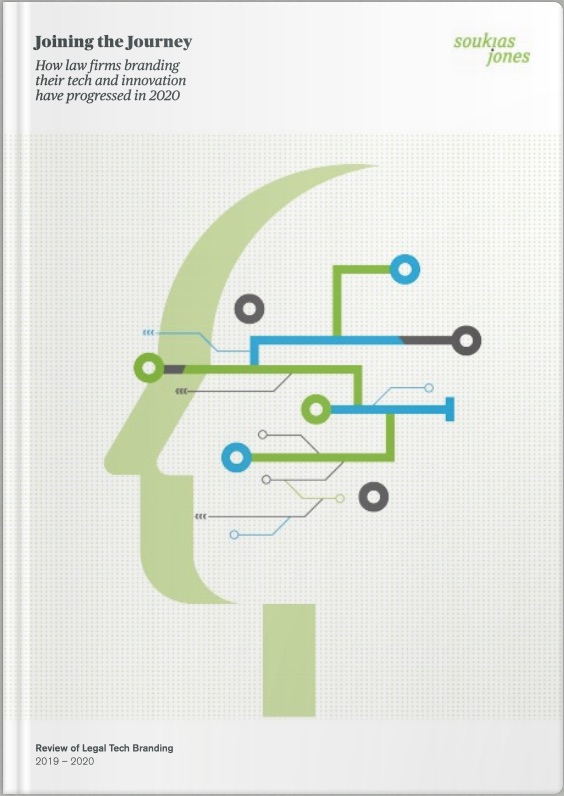
About
Read our new report
How law firms branding tech and innovation have progressed in 2020
Back in June 2019, we published our review ‘How law firms brand innovation and lawtech’. As 2020 closed, we decided to take another look at where firms are on their branding journey. We found:
- 60% of firms (Top 30 UK law firms) now use sub-branding to package their New Law solutions;
- 33% of firms include on their websites little or no reference to innovation and lawtech; and
- 66% of firms in the Top 30 to 60 have little or no reference to these on their websites.
For a free copy of our review ‘Joining the Journey: How law firms branding tech and innovation have progressed in 2020.’ Click here
Contact us
Perhaps your existing strategy is underperforming and failing to deliver results. Do you need help branding your tech?
Set up a no-obligation call with out branding expert, Grahame Jones


